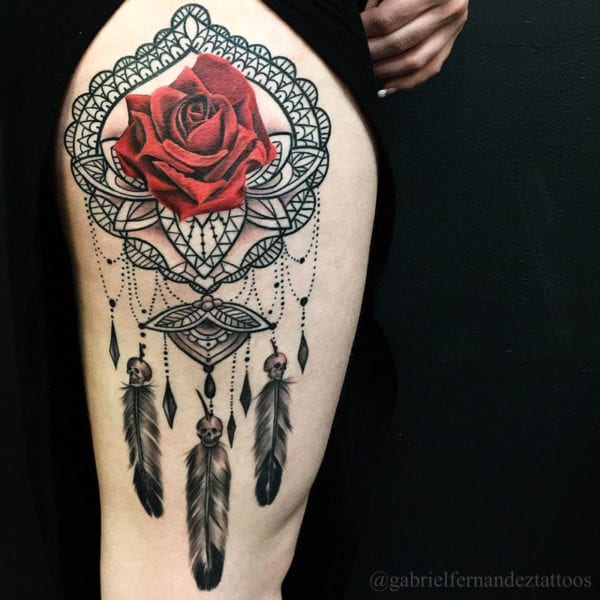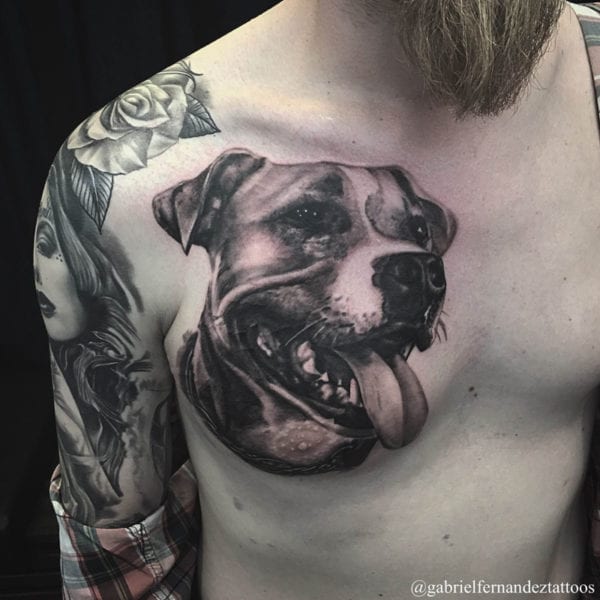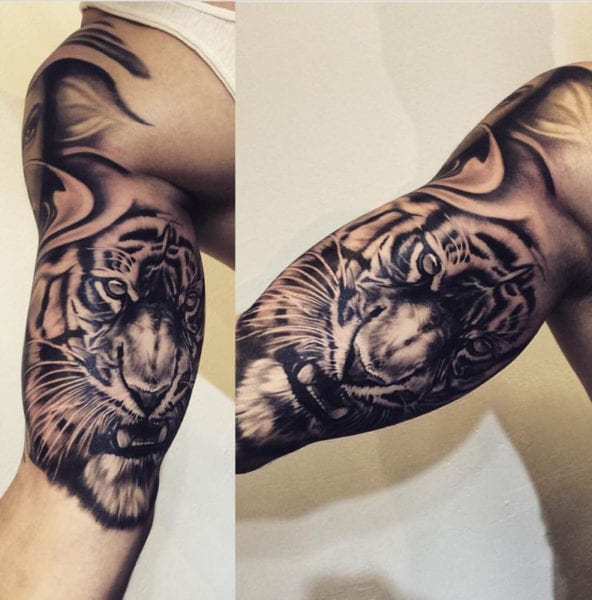A Cuban’s Tattoos
“when a tattoo has a complex design, it’s always a challenge”
By Helson Hernandez
 HAVANA TIMES — Gabriel Fernandez is a Cuban who emigrated to Europe and has become successful for his work where his tattoos have already become pieces of art.
HAVANA TIMES — Gabriel Fernandez is a Cuban who emigrated to Europe and has become successful for his work where his tattoos have already become pieces of art.
HT: Why do you hide in the act of tattooing?
Gabriel Fernandez: Hiding sounds like fear to me, although I also think it sounds like preservation and survival. In my particular case, I think I chose this art form because it’s so complex, it’s not just about drawing on a piece of paper or painting an oil painting, this isn’t an easy art. Needles with ink mark the skin which directly affects a person who feels, thinks and suffers. They move, bleed, sweat, pray for me to stop or laugh. You never really know what’s going through somebody’s mind when you tattoo them. And all of us, every single one of us has our own very different reason for getting a tattoo or tattooing ourselves, which would be very surprising I think if we heard out loud the reasons why people resort to this alternative.
This is where the art of tattooing really lies and it’s a physical expression of who we are, what we’re like and what we’re hiding with this tattoo. Some people prefer to hang up paintings on their walls and others like to see them on their skin, and they’re carrying real art about on them. That’s what attracted me to getting a tattoo in the first place, and then to become a professional tattoo artist.
HT: What other jobs did you have before Tattooing?
GF: Before tattooing, I went through the arduous process of discovering who I was as a person, like a lot of us do. I was born in 1980 and I would never stop drawing when I was at school. My father was an architect and he wanted me to go to an Arts school, but in those times in Cuba, being an artist was considered a strange and useless profession. Later, I tried to apply for a diploma so I could become a graphic designer, architect, I didn’t even know what I wanted to be, but I was looking for something related to drawing/painting, the visual arts, which I couldn’t do in the end anyway. I ended up an average electronics technician and crazy about technical design.
 I don’t think I learned a lot from electronics in the end, and when I had the opportunity to work and study a training course, I chose psychology, while I helped friends decorate cars and engines with stickers that were copied from foreign magazines. Who didn’t use or still have those stickers on their car?
I don’t think I learned a lot from electronics in the end, and when I had the opportunity to work and study a training course, I chose psychology, while I helped friends decorate cars and engines with stickers that were copied from foreign magazines. Who didn’t use or still have those stickers on their car?
Then, I moved to Holland where I became a builder, an interviewer at a call-center and a specialist in natural gas pressurized facilities. That wasn’t because I was choosing a career, I did those things out of necessity so I could purely survive. While I was working this last job and I still never stopped drawing, a very good Cuban friend of mine, who had also emigrated like me, asked me to tattoo him. I had never thought about tattooing, but I let myself try it out and six months after doing my first tattoo, I left everything and committed myself to giving people tattoos.
HT: Tattoos are prejudiced by many, other people see them as an unnecessary mark on the human body and others see it as an art form. What do you think about this?
GF: In Europe, people are less predujiced about tattoos but it still exists. The stigma of tattoos has been significantly reduced thanks to reality shows worldwide. We’re talking about a really radical change from the past when you had to get a tattoo where nobody could see it to the modern day where a global icon has his whole body covered in tattoos and today is a millionaire thanks to the art of tattooing, for example Ed Hardy.
It’s a big culture and social shock to recognize that an internationally renowned tattoo artist makes more money today than a cardiology specialist with over 20 years of experience. Cuba is no longer cut off from global culture’s influence. We are human beings, we want to intellectually, culturally and socially grow so that we can create and revolutionize our development, this is the dialectics we live at the moment.
Before, people used to start getting tattoos where they couldn’t be seen and their hands and neck were the last things they used to tattoo. Nowadays, it’s the complete opposite; they start getting tattoos on their neck or hand and then finish off tattooing themselves where their clothes cover them. In my opinion, this is down to the meaning tattoos have now, the high quality of tattoos today, this loss of fear to express what you want regardless of your profession. I’ve tattooed doctors, lawyers, policemen and unemployed people. Every one of them had their own reasons for exercizing their rights of freedom and self choice. Every one of them in their own world or following standards and stereotypes which are a lot of the time wanted or envied.
HT: Is your tattoo style defined by any trend or aesthetic in particular?
 GF: To be honest, I was talking about this with other tattoo artists about personal styles that different tattoo artists have a few days ago. A lot of them choose a specific style. I personally haven’t found one particular way to tattoo yet. I’m attracted to the diversity there is of styles and customers. Being able to understand what somebody wants to get tattooed and doing it according to what this person wants is a real challenge. There are some people who only want a few letters written on their wrist, but then you have somebody else who wants to create a tree covering their entire back. I think working within these different styles forces me to become a better artist, studying on my own everything I didn’t learn at arts school. I’m quite a perfectionist. I always, unconsciously, add a part of one tattoo to another, and when a tattoo has a really complex design, it’s always a challenge to try and develop it in an effective way.
GF: To be honest, I was talking about this with other tattoo artists about personal styles that different tattoo artists have a few days ago. A lot of them choose a specific style. I personally haven’t found one particular way to tattoo yet. I’m attracted to the diversity there is of styles and customers. Being able to understand what somebody wants to get tattooed and doing it according to what this person wants is a real challenge. There are some people who only want a few letters written on their wrist, but then you have somebody else who wants to create a tree covering their entire back. I think working within these different styles forces me to become a better artist, studying on my own everything I didn’t learn at arts school. I’m quite a perfectionist. I always, unconsciously, add a part of one tattoo to another, and when a tattoo has a really complex design, it’s always a challenge to try and develop it in an effective way.
HT: You’re a Cuban that has emigrated like many others, no?
GF: I immigrated to Holland in 2005 although I’m currently living in Finland. Here, I’ve got my own business which I opened two years ago now.
HT: Do you have any special recommendations for people who might be thinking about getting a tattoo?
GF: The best advice I can give to somebody who wants to get a tattoo is that they find out everything they can about the pros and cons of actually getting a tattoo. What tattoo they want to get, where would be the best place to get it done. What level of hygiene does the tattoo parlour where you’re going to get the tattoo done have and about the tattoo artist’s experience. Don’t ever get a tattoo if you’re drunk or under the influence of drugs.
Click on the thumbnails below to view all the photos in this gallery. On your PC or laptop, you can use the directional arrows on the keyboard to move within the gallery. On cell phones use the keys on the screen.











The obvious difficulty Holguiero is that tattooists us the human skin as a medium. Unlike those used by painters, canvas, board, conditioned wood etc. skin deteriorates with age. My comment is not related to whether any given tattooist is an artist or not. It relates to the appearance of the tattoo as the skin inevitably ages. If the art is outstanding it can be applied to another more permanent surface.
Thanks a lot Carlyle. I just canceled my appointment to have my first ever tattoo. All kidding aside, the tattooist in the article is, in my humble opinion, an artist.
The fashion for tattoos is interesting, but why not a few photographs of tattoos on 70-80 year old people who have either grown fat or lost weight and now have wrinkled baggy skin, both conditions that lead to wild distortion of the original pictures or designs? Tattoos are permanent, smooth youthful skin is not.
Wow there was some nasty tattoos in Cuba years ago. Much higher level of artistic and technical competence these days.
That said, tattoos so popular now that naturally there are a lot of inexperienced and untrained guys still making a buck off it, especially outside the tourist centres.